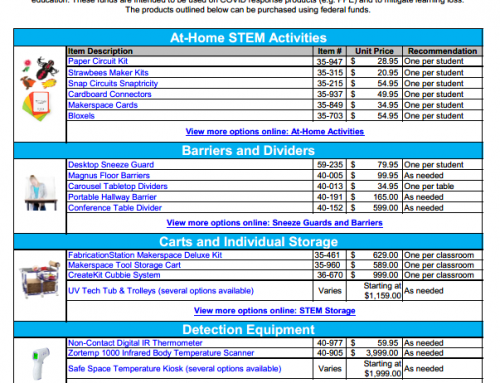As you take in information pertaining to the Education Stabilization Fund it seems to get more and more confusing. Between CARES, CRRSA and ARPA it can be hard to determine if the funding is meant for you or not. Let’s equip you with information to succeed and get you in touch with resources that can give you more information.
How to Prepare:
Ask Your Community
It is important to first determine the resources needed to run a successful program and classroom post-COVID. While you yourself know what works best for you and your current classroom we would recommend reaching out to your students, their parents, and your coworkers. Ask them questions that would help you prepare a better “fight” as you go on to admin, PTO, state representatives and so on. Your coworkers may also be able to let you know how they are approaching asking for funding support. Also ask yourself some important questions and include those in your conversation/ letter.
“I realized I was lacking ___________ in my classroom, therefore I would like to introduce __________.”
Some examples would be:
- What tools could make me a better teacher?
- What products do you want to see in the classroom/makerspace?
- Which topics am I missing due to lack of resources?
- What took a backseat due to digital learning?
- How can I make my classroom more comfortable?
Do Your Research
This should be one of your first steps in asking for federal funding. Come to meetings with admin and your officials with information you have collected. This could be information on the funding itself, allocations, first-hand accounts, letter templates, FaQ’s and so much more. This way meetings or conversations cannot be put on pause due to lack of information.
Need a quick overview of CARES, CRRSA, and ARPA? Get an overview here. If you would like more help with finding questions to prepare check out this blog, “5 Questions to Help Your Secure Federal Funding”

Who To Ask:
-
Superintendent & Principal
These two individuals are meant to be your greatest support system. They should also have a wealth of knowledge when it comes to approaching funding allocations within your school district. If you aren’t comfortable asking your coworkers how they are going about funding support, your superintendent and principal should be able to let you know how others have approached the topic. They should also be able to tell you spent funding totals, proper funding uses, and remaining funding. They should also be able to tell you if you need to apply straight to your state education agency or within your school itself.
-
Local Education Agency
A local education agency or LEA is typically called your board of education. This board has administrative control over public schools in a certain area. They are typically responsible for making policies and overseeing your district’s curriculum, personnel, facilities, and budget. This board is most likely being given all federal funding. They should be the most knowledgeable about the details of the status of your district’s funding. The emails to all board members should be available to the public and you can find who to talk to based on title, and district in their “contact us” tab.

-
State Education Agency
Your SEA should be your [State name] Department of Education or the [State name] Office of Public Instruction. Your state superintendent should have direct contact information available to the public through the website footer or the “Contact Us” tab in the menu. This individual is there to serve your district so feel free to reach out with additional questions your principal or superintendent were not able to answer.








Leave A Comment